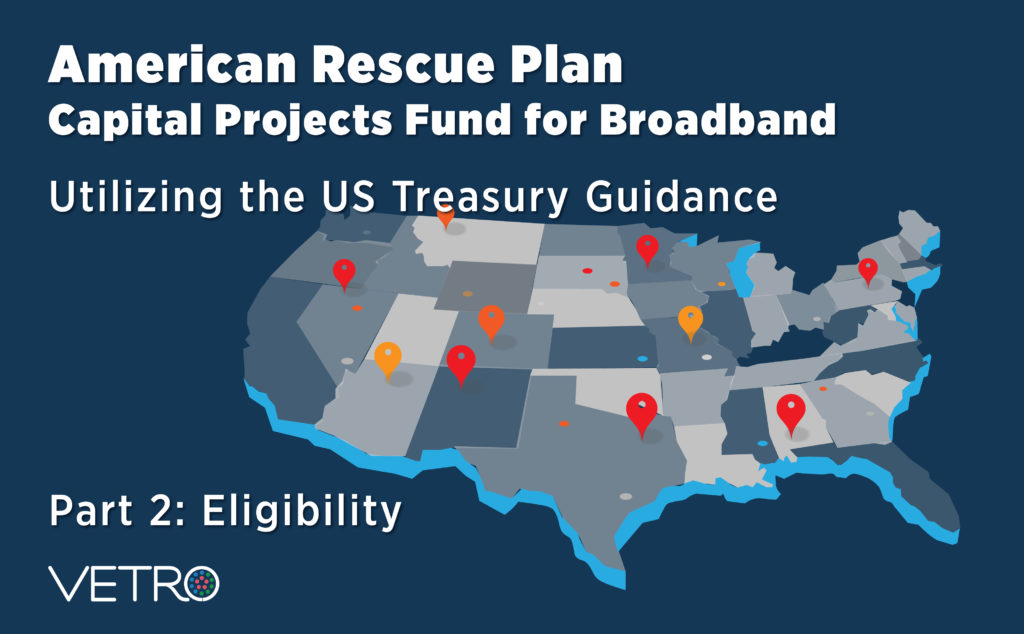
This is our second post in which we take a closer look at the guidance from the US Treasury for utilizing Capital Projects Funding, issued in September of 2020. The agency issued this guidance document to help organizations apply for and use funding from the Coronavirus Capital Projects Fund (Capital Projects Fund).
As a follow up to Part One of our blog series, we address what goes into determining eligibility in today’s post. As always, our focus will be on Broadband Infrastructure Projects.
There are multiple elements that determine eligibility. They include:
- Entities eligible to pursue a grant
- Project types
Eligibility: The Entities
Generally, we know that the American Rescue Plan makes $10 billion available to States, territories, freely associated states, and Tribal Governments “to carry out critical capital projects directly enabling work, education, and health monitoring, including remote options, in response to the public health emergency with respect to the Coronavirus Disease (Covid 19).”
But let’s get specific. This broad category includes:
- each of the 50 states
- District of Columbia
- Puerto Rico
- United States Virgin Islands
- Guam
- American Samoa
- Commonwealth of the Northern Mariana Islands
- Republic of the Marshall Islands
- Federated States of Micronesia
- Republic of Palau.

The guidance notes that Tribal Governments identified in Section 104 of the Federally Recognized Indian Tribe List Act of 1994 are eligible as well. These eligible entities are defined as having a recognized governing body of any Indian or Alaska Native tribe, band, nation, pueblo, village, community, component band, or component reservation.
The State of Hawaii is also eligible to apply for funding under this category. Guidance stipulates that funds must be for exclusive use of the Department of Hawaiian Home Lands and the Native Hawaiian Education Programs to assist Native Hawaiians.
Importantly, these entities, once awarded Capital Projects Fund grants, may award funds to subrecipients. Subrecipients can include other levels of government such as municipalities or counties, nonprofits or private entities.
For instance, subrecipients of funding for Broadband Infrastructure Projects may include cooperatives, utilities or broadband operators and owners affiliated with local governments.
Eligibility: The Project Types
The core requirements for projects tied to Capital Projects Fund grants are:
- The Capital Project invests in capital assets designed to directly enable work, education, and health monitoring.
- Capital Project Funding is designed to address a critical need that resulted from or was made apparent or exacerbated by the COVID-19 public health emergency.
- The Capital Project is designed to address a critical need of the community to be served by it.

There are three types of projects presumed to be eligible although there are specific requirements associated with each type of project. The three types are:
- Broadband Infrastructure projects
- Digital Connectivity Technology Projects
- Multi-Purpose Community Facility Projects
The requirements for each project type vary. Here we focus on Broadband. Subsequent posts will speak to other requirements.
Eligibility: Requirements for Broadband Infrastructure Projects
All Capital Projects Fund projects must support all of the core criteria noted above.
Recipients must design the project that, when complete, will deliver service that reliably meets or exceeds symmetrical download and upload speeds of 100 Mbps. Some exceptions may be made due to topography and geography.
Fiber is not a requirement, but is encouraged for its ability to support future needs.
Recipients must consider the affordability of the broadband service options offered to their target markets in the proposed service area.
All Recipients will be required to report pricing data as part of program performance and monitoring.
Recipients must ensure that service providers for a completed project participate in federal programs that provide low-income consumers with subsidies on broadband internet access services.
Investments in Capital Projects must be carried out in ways that comply with applicable federal laws, including sourcing equipment from foreign countries.
Critical need for access, affordability, reliability, and/or consistency must be explained by the recipient in the context of providing service to the communities they have selected to serve.
VETRO can help accelerate the process of determining eligibility, costing, and go on to support the entire network lifecycle from planning through to build and operations. We provide our software to owner operators as well as government bodies who are committed to building the answer to connectivity for all.
Thank you for reading! Explore our other content or click here to set up a call with one of our experts.

